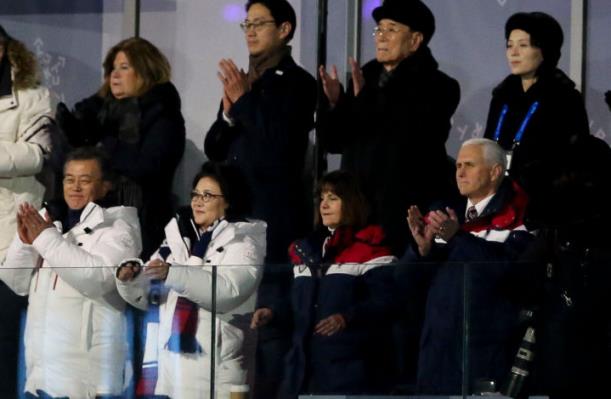
A pause in the war of words between Washington and Pyongyang during the Winter Games has raised optimism that the parties may be interested in pursuing negotiations . But the last 20 -plus years of talks , Paul Saunders notes, have increased mutual mistrust to levels that make any sort of “grand bargain” implausible and ill-advised .
* * *
The 2018 Winter Olympic Games drew considerable attention to South Korea. Now that the competition has ended, however, many eyes are likely to drift northward, to the unresolved nuclear standoff involving not only the two Koreas but also the United States, China, Japan, and others in East Asia. Hopefully the pause has provided an opportunity for new thinking in managing a problem with no easy answers, because it may be possible to do something useful if all sides want to do so.
There are reasons for optimism in that subtle signals suggest Washington, Pyongyang, and Seoul are each interested in pursuing negotiations. Tough talk from US officials increasingly seems intended to encourage and to frame negotiations rather than to short-circuit them. North Korea’s pre-Olympic military parade—and its simultaneous gesture toward the South by offering that its athletes march together with Seoul’s during the opening ceremony (again)—appear similarly motivated.
Nevertheless, there are also reasons for pessimism. Most obviously, North Korea’s track record does not inspire confidence that any agreement would be a meaningful one. No less important, its leader Kim Jong-un seems entirely unwilling to meet the core demand that the United States and others have put forward: an end to Pyongyang’s nuclear weapons program. Some other challenges include the complex dynamics of the three-sided relationship between South and North Korea and the United States—not to mention other interested parties—and equally complex (though quite different) internal politics in the three countries.
Giving Diplomacy Another Try
Still, Washington, Seoul, and Pyongyang may soon give diplomacy another try. This raises important questions: short of an agreement to dismantle North Korea’s nuclear weapons and associated infrastructure, what could they possibly accomplish, and how?
If North Korea is sincere this time, which neither Washington nor Seoul can know without testing, the best options are probably disappointingly incremental. After all, so long as Pyongyang has nuclear weapons, the United States is unlikely to be able to apply sufficient pressure to North Korea to force Mr. Kim or those around him to make major concessions. (Indeed, this is one of the reasons that North Korean leaders want nuclear weapons in the first place.) Conversely, Washington shouldn’t and won’t agree to public acceptance of North Korea’s nuclear arsenal. Neither will South Korea’s leaders.
Beyond this, the last 20-plus years of talks on these issues have increased mutual mistrust to levels that make any sort of “grand bargain” implausible and, from an American perspective, ill-advised. Big deals mean taking big risks that none of the parties seem prepared to embrace, though South Korean President Moon Jae-in appears somewhat more open to this than either Washington or Pyongyang.
What might be possible, however, is boring, step-by-step progress on technical confidence-building agreements, such as advance notification of significant military movements or other transparency measures. This might include some form of conventional arms limitations, though geographical asymmetries prevent the United States from redeploying troops in any degree of parity with North Korea. Though moving beyond confidence-building will probably be quite difficult, negotiators need to maintain a climate of cautious long-term optimism to succeed even in initial steps. Expectations are the key to this, in that hopes for a positive outcome facilitate the flexibility needed to make a deal. If no one thinks an agreement is achievable, everyone will be right—no one will budge from initial negotiating positions and the process will collapse. Of course, maintaining continued pressure on North Korea will also be necessary, though it will be important to do so in a manner that allows for negotiations.
Shift in Public Opinion
Managing US alliances with South Korea and Japan while pursuing talks with North Korea will require considerable skill from the Trump administration and its diplomats. This will be true regardless of who is doing the talking, that is, whether the process is a South-North interaction, a US-North one, or some form of multilateral negotiation involving all three governments and possibly others. In practice, parallel South-North and US-North conversations may be the most likely to work in that Pyongyang probably wants things from both Seoul and Washington but would not want to confront the two allies simultaneously in a trilateral negotiating format. At the same time, a larger multilateral approach like the Six-Party Talks may be less appealing to the United States than in the past in view of China’s growing self-confidence and America’s dysfunctional relationship with Moscow.
President Trump’s frequent harsh rhetoric toward North Korea—and the dawning realization that Pyongyang is an emerging threat to the continental United States—have contributed to a substantial shift in public opinion toward the North, which 51% of Americans now see as the country’s “greatest enemy.” [ http://news.gallup.com/poll/227813/north-korea-surges-top-enemies-list.aspx ] With this in mind, setting aside the substance of North Korea’s security threat, how Mr. Trump and his team manage it could come to define popular assessments of the president’s foreign policy performance, with significant implications for the 2020 presidential campaign cycle. Whether the Trump administration can handle this difficult task remains to be seen, but the American public will be watching closely.
